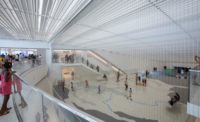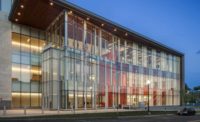The Canal Dock Boathouse in New Haven, Conn. is a new building with strong ties to the past.
It replaces the historic George Adee Memorial Boathouse, which was built in 1911 and served as the home of the Yale University crew teams. It was razed in 2007 to make way for a new suspension bridge over the Quinnipiac river.
It took several years, but the State of Connecticut and the federal government agreed to mitigate the loss of the historic boathouse by funding the design and construction of a new one. The $43 million facility opened in September of 2018.
Designed by Gregg Wies & Gardner Architects, the new Canal Dock Boathouse has a style similar to its predecessor, but uses modern materials—including insulated metal panels.
“It was originally supposed to be clad in terracotta, but the bid for that was an outrageous sum of money,” said Donna Hall, senior project planner for the City of New Haven. “We looked at other materials for the exterior of the building that could not only maintain the integrity, design intent and vision, but also the quality of building we were trying to achieve. We decided on metal panels.”
Richard Wies, principal architect at Gregg Wies & Gardner, says insulated metal panels provide several benefits.
“I like that they’re light weight, their means of fastening and sealing are logical and rational, and that they can be adapted to a wide variety of forms and surfaces,” said Wies. “They have lots of nice finish options, as well as textures and forms of material.”
The 30,000-square-foot Canal Dock Boathouse has 1,278 square feet of Kingspan BENCHMARK Designwall 4000 Architectural Wall Panels, and 254 square feet of BENCHMARK Designwall 2000 Architectural Wall Panels, both in Champagne Bronze. Both panels are ideal for large-scale projects, come in a variety of finishes, deliver high R-values and are GREENGUARD Gold Certified.
The boathouse project also utilizes 8,800 square feet of KarrierPanel Barrier Wall. These panels are installed behind the weathered-wood exterior of the building and provide a thermal and weather barrier as part of the building envelope. The KarrierPanels were designed to provide architects with design flexibility, while delivering the high-performance provided by insulated metal panels.
Inside, visitors get a glimpse into the past, as salvaged pieces of the old boathouse have been incorporated into the new design, including the front entrance, a staircase and a fireplace.
“We took an unusual approach to salvage parts of the old building and integrate them into the new structure,” said Wies.
The two-story building features space for boating activities and storage on the bottom floor, and the upper floor has meeting areas and multipurpose rooms. There’s also a large dock where outdoor events can be held. There is also classroom space on the mezzanine level for students in the marine biology program at the University of New Haven and a museum component that displays elements from the original boathouse building.
“It’s a space where recreation, culture, history, art and education all come together at this amazing location with its great views,” said Hall.
The new building helps dispel the misconception that insulated metal panels have their limits when it comes to architectural design.
“Architecture is about providing good design,” said Wies. “You can work with any material, it’s a matter of execution. There’s so much great architecture out there based on metal panels. It’s like any other material quite frankly—it’s about how well you execute and put it together.”
Owner: City of New Haven, Conn.
General contractor: Nosal Construction, Cheshire, Conn.
Architect: Gregg Wies & Gardner Architects, New Haven, Conn.
Civil engineer: Langan Engineering, New Haven, Conn.
Structural engineer: Spiegel Zamecnik & Shah Inc., New Haven, Conn.
Installer: Ultimate Construction, LLC, West Hartford, Conn.
Metal wall panels: Kingspan Insulated Panels Inc., Deland, Fla. www.kingspanpanels.com




